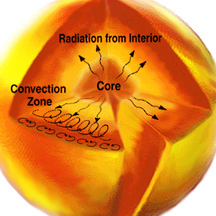Schematic view of the inner structure of the Sun
Click on image for full size and a more detailed image of the interior of the Sun
NASA
The Solar Interior
To understand how our Sun works, it helps to imagine that the interior
of the Sun is made up of different layers, one inside the other. The innermost
layer, the solar core,
is the region where the energy of the Sun is produced. This energy travels
through the next layer of the solar interior, called the
radiation zone, and eventually reaches the
convection zone, where energy is transferred mainly by the
overturning of solar gases.
This convection produces an everchanging pattern of cells on the
surface of the sun.
Direct observations inside the Sun are not possible, however some
diagnostics
exist that allow us to study the Sun's interior.
You might also be interested in:

The convection zone in the Sun occurs above the radiative zone, at about .7 to .8 solar radii from the center of the Sun. At this point the temperature gradient (the change in temperature with depth)
...more
The Sun, as well as other stars, releases energy in the form of radiation and particles. The processes that produce this energy are taking place in the interior of the Sun, where direct observations are
...more
The Sun's radiative zone is the section of the solar interior between the innermost core and the outer convective zone. In the radiative zone, energy generated by nuclear fusion in the core moves outward
...more
Scientists at the High Altitude Observatory (HAO) are working to understand the changes we see in the Sun over time, and how these changes affect the atmosphere of the Earth. There are four main areas
...more
What are the "parts" of the Sun? The photosphere, the visible "surface" of the Sun, defines the outermost boundary of the "inside" of the Sun. The three main regions of the
...more
The scientific field of thermal physics is concerned with heat and temperature. When we delve into topics such as global warming, the structure of Earth's solid and liquid cores, and the way in which energy
...more
IMF stands for Interplanetary Magnetic Field. It is another name for the Sun's magnetic field. The Sun's magnetic field is enormous and is carried by the solar wind. The solar wind and magnetic field are
...more
"Without warning, the relatively calm solar atmosphere can be torn asunder by sudden outbursts of a scale unknown on Earth. Catastrophic events of incredible energy...stretch up to halfway across the visible
...more












